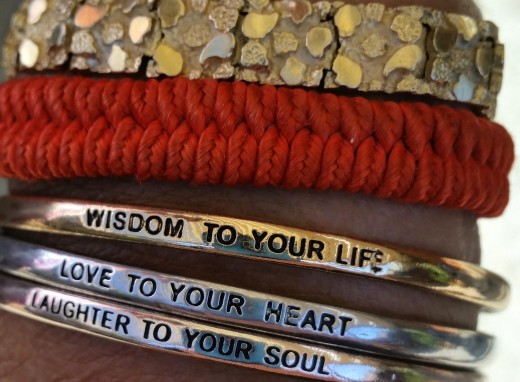Women Struggling With Humility [Part 4]
Airhead sounds better in Hebrew
My teacher from Jerusalem, Yudit Cohen-Shoore, of blessed memory, also known as Moriya, once said to me, ‘Ego-driven choices are attention-seeking attitudes. They come from the opposite of humility in our heart. They lead to frivolous thinking and immodest behaviour in thoughts, words, feelings and actions. They are kalut rosh - the Hebrew expression for reckless actions that denote a light-headed, childlike brain.’
Yudit continued, ‘The opposite of kalut rosh is tzniut, modesty, which broadly stands for a code of moral conduct known as humility. In truth’, she concluded, ‘what is most scarce in the world today is humility, not necessarily modesty.’

Indeed, regardless of age and gender, persons who behave humbly speak quietly. They walk lightly and tread carefully for the greater good of all, including their own.
Persons who have adopted humility as a way of life do not bring attention on to themselves. They are quiet achievers.
Humility has never stopped anyone from being attentive, creative, loving, organised, funny, diligent and responsible at the highest of levels.
Of course, one must never confuse deliberate and nourishing humility with cowering insecurity. Practising Tzniut is practising humility.
What you get is not all there is
The endemic practice of posturing which governs how we present ourselves, talk, and act, in the many ways, screams out ‘Look at my legs, my pecs, my hair! Look at my bling, my car, my bike, my house! Sure, I’m so cool/sexy! I’m all dolled up because I can! I push boundaries! I’m daring! I’m a hunk! Don’t mess with me, or I’ll eat you alive’.
Such a practice is the tacit bid to let appearances, however elusive they are, outshine the divine beauty of our inner self.
Thankfully for each one of us, what can be seen by all is never all there is.

Self-serving
Letting loose impulsive, 'kalut rosh' thoughts do not make good emotional/spiritual sense.
It leads neither to resilience nor coherence. It does, however, lead to performance anxiety.
It unleashes a myriad of energetic ripples that, on the whole, lead us directly to each of the critical moments where we are made to reap what we have sown even if, by then, we fail to recognise or even suspect a connection between cause and effect.
There is nothing odd in stating that a healthy practice of humility is self-serving.
Good gear
All religious diatribe aside, when it comes to garments suitable for the modern woman who chooses to practice humility, the current range of fashion items makes it easy.
Loose linen trousers are valid options. So are maxi dresses and skirts in muted tones and the plethora of long-sleeved tunics or loose shirts that reach down mid-thigh.
Add to that a cosy sweater, a cardigan, drape, cape or coat, depending on the season, plus the newly resurrected iconic espadrilles, flat or low heels shoes - and all the essential boxes get ticked.
Off on a tangent
However, as the mind meanders on the spectrum of modesty and humility, it wonders what boxes get ticked by the exotic beauty of designer scarves, hijabs and abayas and their riot of colours.
What is the silent message of lips brightened by red lipstick and eyes made sexily dusky by traditional kohl or mascara and eyeliner?

L'Oreal and hijabs
In January 2018, Amena Khan, an amazingly beautiful, hijab-wearing model, was signed as the latest face of L’Oreal Paris. She stepped down a week later because of a backlash following the surfacing of some anti-Israel tweets posted in 2014 and said to be offensive.
Beyond confirming that what we do at any given moment may well ripple out to bite us on the tail later and, that notwithstanding, generally speaking, how do orthodox religious women reconcile faces made dazzling by make-up further enhanced by a colourful hijab, shawl or scarf with the active practice of modesty or humility, as required by their faith and culture?
How do arresting sunglasses and eye-catching accessories fit in?
Similarly, what about online pictures of appealing, muscular young men decked out in sleeveless T-shirts and skinny black jeans, brooding eyes flirting with the camera - with or without beards or earlocks but with a kippa, skullcap or turban tilted on a manly, but jaunty angle while posturing for their cause?

Clarity - certainty - constancy
Serious question: how to achieve religious congruence – or any other congruence for that matter - when it requires a match between one’s image of self (our public face) and one’s ideal self (the sort of person we would like to be)?
Clarity. Certainty. Constancy = Coherence. Congruence. Resilience.
These are the arrows that we, men and women of all ages, must somehow craft and add to our quiver.
Next, we must render them immutable because we understand that we are not merely what our brain tells us we are – or what we aspire to become. We are much more than that.
Stand up - front up - confront
‘We are all born to stand out’, said 19-year-old Halima Aden, a stunning, radiant young woman who made it all the way to the semi-finals of the 2016 Miss Minnesota USA Pageant.
More than an achievement, fronting up to each of the many auditions and lead up events to such a pageant, particularly, perhaps, in Midwest America, wearing a hijab is a great act of courage.
Better than that, it is an act of conviction – an act of blind faith – and an act of defiance, too.

A badge of honor, a cultural symbol or a symbol of humble invisibility?
Wearing any visible badge, head covering- skullcaps and hats included - as an identifying brand in the name of any belief - as a symbol of ‘revolution’ - is a courageous thing.
But, in regards to the wearing of these items as a voluntary act of [religious] modesty, unless the wearers, regardless of age and gender, actively accept these coverings as cloaks of ‘invisibility’ donned willingly and purposefully, they are faced with a conflict of ideology.
‘The hijab,’ Halima explained, ‘is a symbol that we wear on our heads, but I want people to know that it is my choice. I’m doing it because I want to.’
She added, ‘I wanted people to see that you could still be really cute and modest at the same time.’
The thing is, women do not get that far ‘up the ladder’ of beauty pageants by dressing modestly, looking humble and diverting the limelight from the self, even as they wear a slinky burkini.
From a layperson whose mind meanders
The following very earnest questions aim beyond the court of public opinion which has always been harsher on women than on men.
While women of faith are concerned about showing how ‘modern and normal’ they are, how do those who ‘religiously’ cover their hair achieve more than athletes draped in their country’s flag at international sporting events?
How does the mass of millennials wearing tight tops and equally tight-fitting jeans while a scarf covers their head reconcile moral clarity, certainty, and constancy with their principal intention to confirm that they are not oppressed by patriarchy?
How do [religious] women gain a higher degree of coherence while intent on confirming that, like every other person, they are free to dress fashionably, to be beautiful, i.e. to be sexually desirable?
How to ‘stand out’, as exquisite Halima said, in a way that is congruent and coherent with one’s inner core?
Regardless of the context, it is within this massive conundrum that lies one of the most active components of our human tragedy – one that, unfortunately, does not allow for compromises.
A validation or consolation
Beyond that, we remember that, regardless of age and gender, the reward for developing self-control through modesty/humility is an essential mitzvah/good deed/hasanah logged on our behalf.
‘Sweet!’ one might say wrily, ‘but what is in it for us in the short-term?’

Evil Eye?
New side-wandering mind meander is coming on as a consideration of what might be ‘in it’ for us.
Is there such a thing as the ‘evil eye’?
Again, the answer will vary according to one’s belief system, but it is said that ayin hara in Hebrew, the so-called evil eye, is triggered by the negative charge in a person’s gaze when it is loaded with envy, loathing or any other misguided thinking.
A poison by any other name is toxic
Poisonous moments that lead to anxiety, fear, insecurity, the encroaching a sense of being ‘less than’ that propels millions and millions of us, children, men and women of all ages towards depression, chronic ill-health and at-risk behaviours are increasingly prevalent in our culture.
Energetic ripples linked to being - or feeling - resented, negatively envied, discredited, insulted, mocked, ridiculed and the confusion and pain that ripple outward are indeed on par with the curse of ‘the evil eye’.

When it strikes
It always takes a lot more than a good luck amulet, a length of red or indigo wool tied around the wrist - or prayers - to keep us afloat.
Ask anyone who has ever been belittled or harassed in the home, playground, workplace, anywhere within their first circle of influence, in the streets, in venues or on social media.
What is good for the soul can only be nectar to our psyche, to our persona – to each one of us.

© 2018 Carole Claude Saint-Clair







